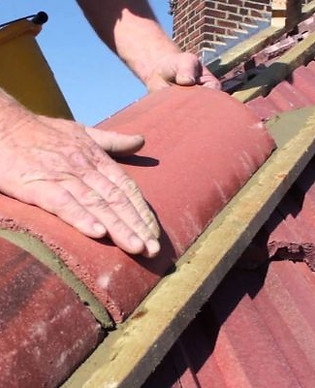We Are Experts In Replacing Or Repairing Ridge tiles

Ridge Tile Repairs
We repair all ridge tiles
If you are having problems with your ridge tiles, call us today, and we can drop by your home to check them out.
Repairing Ridge tiles
The ridge tiles on your roof are vulnerable to weather damage since they are the most visible. Over time, mortar slowly deteriorates, and when paired with adverse weather conditions, this can result in loosened ridge tiles. This deterioration can be caused by rainfall seeping through tiny crevices, freezing and cracking the mortar. When this occurs, fresh cement must be used to repair the tiles. Broken ridge tiles must be replaced with tiles of the same colour and profile, which may be difficult to find in older homes. If this is the case, it may be necessary to replace the whole ridge.
Re-Bed Ridge tiles
Leeds & District Roofing is available for re-bedding ridge tiles. Ridge tile re-bedding may be required for various reasons, including aged materials, a poor mixture, or previous incorrect work. While some Leeds roofing companies take shortcuts, we damp ridge tiles at Leeds & District Roofing before re-bedding them into a tried-and-true mixture of materials, including sand, sharp sand, and cement. As such, if you need a reputable roofing company in Leeds to re-bed your ridge tiles, don't hesitate to get in contact with us to discuss your options.
Dry Ridge Systems
Because of BS 5534, all newly constructed roofs must have a dry ridge system installed by the building control department. This is because mortar-bonded ridge tiles' durability may be affected by a number of external influences. A dry ridge, on the other hand, ensures that the roof tiles stay put even in the most adverse conditions. This drastically lowers the likelihood of damage, while dry ridging doesn't need the same level of upkeep that mortar does. Please note that BS 5534 does not apply to the repair of pre-existing roofs or to certain listed and historic properties.
The conversion of roof ventilation is another option made possible by a dry ridge. This, in turn, helps to avoid the formation of potentially hazardous condensation. Condensation is bad for your roof's health and may lead to leaks, damage, and mould if left unchecked.
Experienced
%20(2).jpg)

Leeds & District Roofing Services LTD excels in ridge work due to our skilled team and commitment to quality. With years of experience, we deliver top-notch roofing solutions that stand the test of time. Our professional roofers are dedicated to providing exceptional service, ensuring your roof is in expert hands. Trust Leeds & District Roofing Services LTD for all your roofing needs.
Professional Roofers





